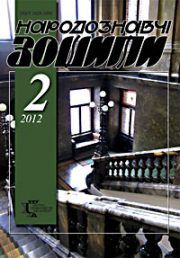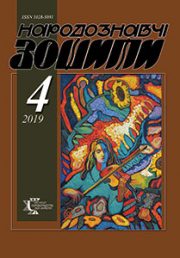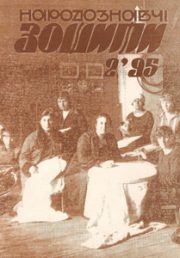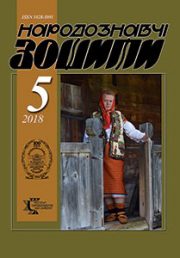2024 #5 Bilous V.
The Ethnology Notebooks. 2024. № 5 (179), 1058—1072
UDK 908(479):[94-051:001.891](477)”18/19″
DOI https://doi.org/10.15407/nz2024.05.1058
THE CAUCASIAN STUDIES VECTOR IN THE RESEARCH OF MYKHAILO HRUSHEVSKYI
BILOUS Vira
- ORCID ID: https://orcid.org/0000-0001-7848-180X
- Candidate of Historical Sciences,
- Senior Researcher,
- The Institute of Ethnology of the NSU,
- The Department of Modern Ethnology,
- 15, Svobody Avenue, 79000, Lviv, Ukraine,
- Contacts: e-mail: bilka3@gmail.com
HUZII Roman
- ORCID ID: https://orcid.org/0000-0003-4134-956X
- Candidate of Historical Sciences,
- Senior Researcher,
- The Institute of Ethnology of the NSU,
- The Department of Modern Ethnology,
- 15, Svobody Avenue, 79000, Lviv, Ukraine,
- Contacts: e-mail: etnomod@ukr.net
Abstract. Problem Statement. The multifaceted legacy of Mykhailo Hrushevskyi covers, in addition to Ukrainian studies, the most diverse directions of world humanitarian studies, in particular, the area of historical and ethnographic studies of the Caucasus. The scientist’s analytical judgments in this field are scattered in his colossal output and have not received adequate coverage in national historiography. Their understanding will help clarify the contribution of M. Hrushevskyi to the knowledge of world history and form a more complete idea of the breadth of his ascetic scientific work.
The purpose of the article is to reveal M. Hrushevskyi’s achievements in Caucasian studies, determine his novelty and role in the national and foreign historical-scientific discourse of the 19th-early 20th centuries, and determine his significance for the intellectual heritage of Ukraine and the Caucasus.
The biographical method made it possible to detect the origins of M. Hrushevskyi’s scientific interest in the traditional heritage of the peoples of the Caucasus; the method of historiographical analysis made it possible to establish the specificity of the scientist’s ethnographic researches and their place in the historical concept of M. Hrushevskyi; the comparative-historical method made it possible to determine the innovation of his research in the specified area.
The analysis of Hrushevskyi’s heritage resulted in determining of his work in the field of ethnology, ethnic history, archeology of the peoples of the North Caucasian, Kartvelian and Iranian language families of the Caucasus. The primacy of M. Hrushevskyi in the study of Ossetian-Ukrainian convergences in decorative and applied art has been established.
The conclusions emphasize the conceptual significance of M. Hrushevskyi’s Caucasian studies for solving the issues of ethnic history and ethnospecificity of the traditional culture of Ukrainians, as well as for ethnology of the North Caucasus and Transcaucasia..
Keywords: M. Hrushevskyi, peoples of the North Caucasus and Transcaucasia, Caucasian studies, ethnic history, ethnography, archaeology, source studies, Adyghe, Ossetians, Georgians, Alans.
Received 29.08.2024
REFERENCES
- Kryp’jakevych, I. (1935). Michael Hrushevsky. Life and activsti. L’viv [in Ukrainian].
- Vynar, L. (1967). Early Years of Michael Hrushevsky 1866—1894. Munchen; New York[in Ukrainian].
- Burmaka, H. (2019). Thematic palette of the prose works of Mykhailo Hrushevs’kyj. In M. Hrushevs’kyj, Studio and source (Book 2, pp. 96—120). Kyiv [in Ukrainian].
- Sheludiakova, N. (2016). M. Hrushevs’kyj is a collector in the context of the scientific and artistic life of Ukraine at the end of the 19th and the beginning of the 20th centuries. (Doctoral dissertation). Institut of the History of Ukraine of the National Academy of Sciences of Ukraine. Kyiv [in Ukrainian].
- Tel’vak, V. (Ed) (2014). Correspondence of M. Hrushevs’kyj wich M. Marr Ukrainian Historical Yournal, 4 (517), 187—193 [in Ukrainian].
- Dashkevych, Ya. (2004). Mykhailo Hrushevs’kyj at the of XIX century. In M. Hrushevs’kyj, Works: in 50 vol. (Vol. 6, pp. I—XIII). L’viv: Svit [in Ukrainian].
- Maslijchuk, V. Early Mykhailo Hrushevs’kyj`s reviews. In M. Hrushevs’kyj. Works: in 50 vol. (Vol. 14, pp. XX—XL). L’viv: Svit [in Ukrainian].
- Gordiyenko, D. (2013). The Works by N.R. Kondakov in M.S. Hrushevsky’s Evaluating. Kondakov’s readings IV: Antiquity — Byzantium — Ancient Rus (Pp. 5—16). Belgorod [in Ukrainian].
- Hrushevs’kyj, M., & Yas’, O. (Ed). (2016). The Steppe and the Sea in the History of Ukraine. Some Words about Plans and Prospects of this Study. Ukrainian Historical Yournal, 1 (526), 176—194 [in Ukrainian].
- Bubenok, O. (2006). The question of relationship between Alans and the medieval nomads of Eurasia in the works of Eastern European and Western researchers. The Word of the Orient, 4, 27—46 [in Ukrainian].
- Hrytsyk, L. (2009). «Literature between two world» Estern world, literary aspect. Bibliia i kul’tura, 1, 61—65 [in Ukrainian].
- Nechuj-Levyts’kyj, I. (1968). Letters. In I. Nechuj-Levyts’kyj, Collected works: in 10 vols (Vol. 10, pp. 255—502). Kyiv: Naukova dumka [in Ukrainian].
- Hrytsyk, L. (2019). Oriental Discourse of L.S. Nechuy-Levytsky. Literary Studies. Collection of scientific works output (Issue 3 (57), pp. 57—69). Kyiv: Publishing house «Kyiv University» [in Ukrainian].
- Hrushevs’kyj, M., & Bilokin’, S. (Ed). (1988). Memories. Kyiv, 11, 120—137 [in Ukrainian].
- Hrushevs’kyj, M. How I used to be a fiction write. In M. Hrushevs’kyj, Works: in 50 vol. (Vol. 12, pp. 1—6). L’viv: Svit [in Ukrainian].
- Hrushevs’kyj, M. (1926). Autobiography. L’viv [in Ukrainian].
- Hrushevs’kyj, M., & Zashkil’niak, L. (Ed). (1993). Diary (1883—1884). Kyivs’ka starovyna, 5, 13—24 [in Ukrainian].
- Hrushevs’kyj, M. (2011). Kinto Mikhako. In M. Hrushevs’kyj, Works: in 50 vol. (Vol. 12, pp. 366). L’viv: Svit [in Ukrainian].
- Hrushevs’kyj, M., & Bilokin’, S. (Ed). (1988). Memories. Kyiv, 10, 131—138 [in Ukrainian].
- Hrushevs’kyj, M., & Bilokin’, S. (Ed). (1988). Memories. Kyiv, 9, 115—140 [in Ukrainian].
- Yevtushenko, Yu. Powder flask from Mykhajlo Hrushevsky’s collection of antiquities. Retrieved from: http://hrushevsky.history.org.ua/cgi-bin/hrushevsky/person.exe?C21COM=2&I21DBN=ELIBH&P21DBN=ELIBH&Z21ID=&Image_file_name=DOC/0008978.pdf (Pp. 1—10) (Last accessed: 13.06.2024).
- Hrushevs’kyj, M. (1991). History of Ukraine-Rus’: in 11 vol., 12 books (Vol. 1). Kyiv: Naukova dumka [in Ukrainian].
- Hrushevs’kyj, M. (1992). History of Ukraine-Rus’: in 11 vol., 12 books (Vol. 3). Kyiv: Naukova dumka [in Ukrainian].
- Hrushevs’kyj, M. (2007). On the threshold of the new Ukraine. Thoughts and dreams. In M. Hrushevs’kyj, Works: in 50 vol. (Vol. 4, book 1, pp. 225—266). L’viv: Svit [in Ukrainian].
- Hrushevs’kyj, M. (1993). History of Ukrainian Literature: in 6 vol., 9 books (Vol. 1). Kyiv: Lybid’ [in Ukrainian].
- Hrushevs’kyj, M. (2015). Regional historical research of Ukraine and examination of the Kyiv junction. In M. Hrushevs’kyj, Works: in 50 vol. (Vol. 10, book 1, pp. 151—172). L’viv: Svit [in Ukrainian].
- Nenasheva, O. (2009). I.V. Morgilevsky’s architectural studies. Borrowing theory in the context totalitarian science of the 1920s and 1930s. Modern problems of research restoration and preservation of cultural heritage: a collection of scientific works (Issue 6, pp. 163—199). Kyiv [in Ukrainian].
- Logvyn, G. (1994). Mykhailo Hrushevs’kyj’s ideas in the history of Ukrainian art.In M. Hrushevs’kyj, A collection of scientific works and materials of the International Scientific Conference dedicated to the 125th anniversary of the birth of Mykhailo Hrushevs’kyj (Pp. 275—280). L’viv [in Ukrainian].
- Hrushevs’kyj, M. (2004). Molotov silver. Archaeological note. In M. Hrushevs’kyj, Works: in 50 vol. (Vol. 6, pp. 361—366). L’viv: Svit [in Ukrainian].
- Hrushevs’kyj, M. (2005). Kovtky of the «Kyiv type» in modern Caucasians. In M. Hrushevs’kyj, Works: in 50 vol. (Vol. 7, pp. 319—321). L’viv: Svit [in Ukrainian].
- (1888). Information about the meetings of the Historical Society named after Nestor the Chronicler in 1878—1888. Reading in Historical Society named after Nestor the Chronicler (Book 2, pp. 6—285). Kyiv [in Russian].
- Riabtseva, S. (2000). Three-bead Rings from Vistula to Volga. Stratum plus, 5, 161—182 [in Russian].
- Pasternak, Ya. (1961). Archaeology of Ukraine. Toronto [in Ukrainian].
- Dashkevych, Ya. (1993). Rus’ and Armenia. Confessional and Cultural Contacts in the IX — First Half of the XIII Centuries. Notes of the Shewchenko Scientific Society (Vol. 225, pp. 167—184) [in Ukrainian].
- Bubenok, O. (1997). The Jases and Brodniks in the Steppes of Eastern Europe (VI — beginning of XIII th centuries). Kyiv: Logos [in Russian].
- Hrushevs’kyj, M. (2004). Antes. Excerpt from the history of Ukraine-Rus’. In M. Hrushevs’kyj, Works: in 50 vol. (Vol. 6, pp. 452—464). L’viv: Svit [in Ukrainian].
- Pasternak, Ya. (1975). The Early Slavs in Historical, Archeologial and Linguistic Studies. New York; Toronto; Paris; Munchen [in Ukrainian].
- Uvarova, P. (Ed). (1905). Proceedings of the XII Archaeological Congress in Kharkiv (Vol. III). Moscow [in Russian].
- Hrushevs’kyj, M. (1995). History of Ukraine-Rus’: in 11 vol., 12 books (Vol. 7). Kyiv: Naukova dumka [in Ukrainian].
- Kushan, D., & Lastovskyi, V. (2016). Archeology and Early History of Cherkasy. Kyiv; Cherkasy [in Ukrainian].
- Novikova, L. (2015). Question on Circassian (Checasy) version on the origin of Cossacksin the historical works in XVIII — the first third of XIX c. Chornomors’ka mynuvshyna (Issue 10, pp. 56—67) [in Ukrainian].
- Hrushevs’kyj, M. (1991). The outline of the history of Kyiv land from the death of Yaroslav to the end of the 14th century. Kyiv: Naukova dumka [in Ukrainian].
- Yu., S. [Sitsins’kyj Yevfymij]. (1901). [Review]. Kulakovskij Ju. Alans according to classical and Byzantine writers. Notes of the Shewchenko Scientific Society (Vol. XLII, issue IV, pp. 5—6) [in Ukrainian].
- Hrushevs’kyj, M. (2012). [Review]. Kulakovskij Ju. Christianity in the Alans. In M. Hrushevs’kyj, Works: in 50 vol. (Vol. 15, p. 15). L’viv: Svit [in Ukrainian].
- Hrushevs’kyj, M. (1992). History of Ukraine-Rus’: in 11 vol., 12 books (Vol. 2). Kyiv: Naukova dumka [in Ukrainian].
- Hrushevs’kyj, M. (2005). A review of N. Kondakov’s works on the history of Old Russian art. In M. Hrushevs’kyj, Works: in 50 vol. (Vol. 7, pp. 483—494). L’viv: Svit [in Ukrainian].
- Hrushevs’kyj, M. (2008). [Review] Latyshev V. Proceedings of ancient Greek and Latin writers about Scythia and the Caucasus. Vol. 1. Issue 1. SPb., 1893. In M. Hrushevs’kyj, Works: in 50 vol. (Vol. 14, pp. 3). L’viv: Svit [in Ukrainian].
- Hrushevs’kyj, M. (2012). [Review] Latyshev V. Proceedings of ancient Greek and Latin writers about Scythia and the Caucasus. Vol. 1. Issue 2. SPb., 1896. In M. Hrushevs’kyj, Works: in 50 vol. (Vol. 15, pp. 9). L’viv: Svit [in Ukrainian].
- Hrushevs’kyj, M. (2012). [Review] Latyshev V. Proceedings of ancient Greek and Latin writers about Scythia and the Caucasus. Vol. 1, Issue 3. SPb., 1900. In M. Hrushevs’kyj, Works: in 50 vol. (Vol. 15, pp. 44). L’viv: Svit [in Ukrainian].
- Hrushevs’kyj, M. (2012). [Review] Lappo-Danilevskij A., Mal’mberg I. Tumulus Karagodeuashh. SPb., 1894. In M. Hrushevs’kyj, Works: in 50 vol. (Vol. 15, pp. 64). L’viv: Svit [in Ukrainian].
- V., H. [Volodymyr Hnatiuk]. (1896). [Review]. A collection of materials for the description of localities and tribes of the Caucasus. Tyflis, 1894, vol. I—XX. Notes of the Shewchenko Scientific Society (Vol. XI, issue III, p. 41) [in Ukrainian].
- Hrushevs’kyj, M. (2012). [Review]. A collection of materials for the description of localities and tribes of the Caucasus. Tyflis, 1896—1897, vol. XXI—XXII. In M. Hrushevs’kyj, Works: in 50 vol. (Vol. 15, pp. 64). L’viv: Svit [in Ukrainian].
- Vovk, F. (1906). The Caucasus and the Carpathians. Some attempts at ethnological approachings. Scientific collection dedicated to Professor M. Hrushevs’kyj by students and supporters on the occasion of his ten-year scientific work in Galicia (1894—1904) (Pp. 595—600). L’viv [in Ukrainian].







